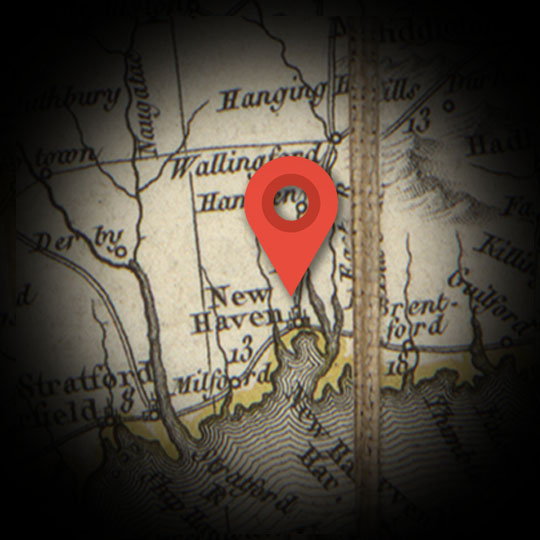NEW HAVEN
Explore
A storied city in the annals of American history going back to some of the earliest colonial times, New Haven played a role during the Revolutionary War as a battle site, and its Yale College educated literally dozens of noted American patriots including five signers of the Declaration of Independence and six delegates to the federal convention that drafted the U.S. Constitution.
It was also the home for some time of Connecticut-born Benedict Arnold, who—after Hamilton was on hand to see his treasonous plot unravel at West Point—returned to this same stretch of the Connecticut coast in British uniform to torch the city of New London in 1781.
But it was neither as a soldier nor as a legislator that brought Alexander Hamilton to New Haven in 1797 and 1798. He traveled here (then reportedly an eight-day round trip from New York City) in his capacity as a lawyer.
The cities of New Haven and Hartford, prior to 1873, alternated as the capital, playing host to the state government. And so it happened that the U.S. Circuit Court for the District of Connecticut was sitting in New Haven as it began its term in April, 1798, and took up a case for which Hamilton was serving as defense counsel.
The case Hamilton was working on—called the “Connecticut Gore” controversy—involved complicated issues of constitutionality and history. Two of Hamilton’s legal specialties were real estate and border disputes, and the Connecticut Gore case involved both.
Even as late as 1798 there were remained thorny issues of tracts of U.S. land still that were still being claimed by more than one state. Connecticut’s 1662 royal charter, as with several other states, set its western boundary all the way to the Pacific Ocean! This vast territory was soon whittled away, both by the state giving up some of its western lands and also losing it in legal controversies to Pennsylvania.
But one 2 mile wide, 220 mile long strip of land along the Delaware River where New York meets Pennsylvania seemed to one pair of land speculators to still belong to Connecticut. These speculators, Jeremiah Halsey and Andrew Ward, obtained from Connecticut the title to this tract. But New York asserted that this “gore” (a now-defunct term for a wedge-shaped or triangular piece of land) belonged to it.
A legal battle ensued, and Hamilton was called on to represent New York. He appeared in court alongside the state’s sitting attorney general, Josiah Ogden Hoffman. Hoffman, like Hamilton, was a dedicated member of the Federalist Party. In fact, Hamilton nearly once wound up in a duel with one James Nicholson when Hamilton tried to intercede in an argument between Nicholson and Hoffman in 1795.
Hamilton’s legal strategy and legal theory was that only the Supreme Court of the United States could decide an issue between two states. And he filed motions attempting to get the case moved up to the highest court. The matter was, however, eventually dismissed, and New York retained its claim to the Connecticut Gore.
Hamilton earned $800 for his legal work for New York State.
Hamilton also passed through New Haven on June 8, 1800, at the beginning of a tour of several New England states to electioneer for Charles Cotesworth Pinckney, and against his rival John Adams, in the coming presidential election.
He remarked on the local landscape in a letter to his wife, Elizabeth Hamilton, declaring that “the country is truly charming.”

TIME FRAME:
April, 1798 & June, 1800
